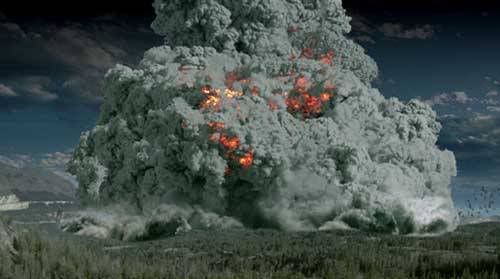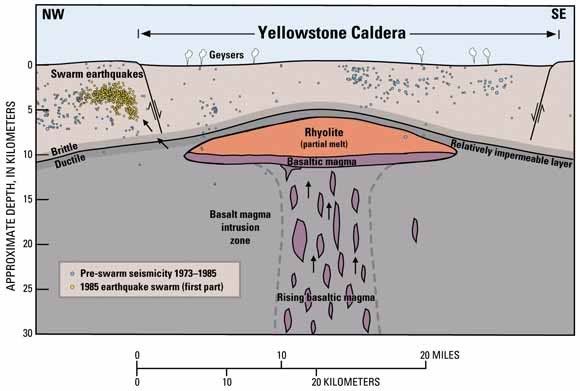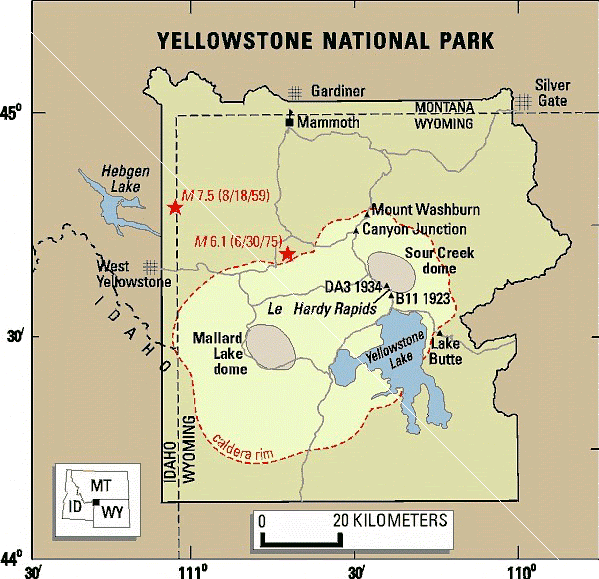Supervolcanoes

Being such well informed nature peps I'm sure everyone's already heard of the supervolcano, or megacaldera as it's sometimes called, under Yellowstone that's set to erupt at any time and kill us all. Supervolcanoes are such mega-colossal events (aka: We're all going to die!) so I thought they deserved a post of their own.

Supervolcanoes begin life when magma rises from the mantle to create a boiling reservoir in the Earth's crust. This chamber increases to an enormous size, building up colossal pressure until it finally erupts. The explosion would send ash, dust, and sulfur dioxide into the atmosphere, reflecting the sun's rays and creating a cold wave lasting several years. It's a volcano that produces the largest and most voluminous kinds of eruption on Earth. The explosivity of such eruptions varies, but the volume of ejected tephra is enough to radically alter the landscape and severely affect global climate for years, with cataclysmic consequences for life on earth.
Though there is no well-defined minimum explosive size for a "supervolcano", there are at least two types of volcanic eruption that have been identified as supervolcanoes: massive eruptions and large igneous provinces.
Massive eruptions are eruptions with a Volcanic Explosivity Index of 8 (VEI-8) that eject at least 1,000 km³ of pyroclastic material. VEI-8 eruptions are so powerful that they form circular calderas rather than mountains because the downward collapse of land at the eruption site fills emptied space in the magma chamber beneath. The caldera can remain for millions of years after all volcanic activity at the site has ceased.
The other type of eruption is a large igneous province (LIP), an extensive region of basalts on a continental scale, resulting from flood basalt eruptions. When created, these regions often occupy several million km² and have volumes on the order of 1 million km³. In most cases, the majority of this is laid down over an extended but geologically sudden period of about several million years.
VEI-8 volcanic events have included eruptions at the following locations.
Lake Taupo, North Island, New Zealand - Oruanui eruption 26,500 years ago (1,170 km³)
Lake Toba, Sumatra, Indonesia - 75,000 years ago (2,800 km³)
Yellowstone Caldera, Wyoming, United States - 2.2 million years ago (2,500 km³) and 640,000 years ago (1,000 km³)
La Garita Caldera, Colorado, United States - Source of the truly enormous eruption of the Fish Canyon Tuff 27.8 million years ago (~5,000 km³)
The Lake Toba eruption plunged the Earth into a volcanic winter, eradicating an estimated 60% of the human population (although humans managed to survive, even in the vicinity of the volcano), and was responsible for the formation of sulfuric acid in the atmosphere.
Eruptions of the Yellowstone volcanic system have included the two largest volcanic eruptions in North America in the past few million years; the third largest was at Long Valley in California and produced the Bishop ash bed. The biggest of the Yellowstone eruptions occurred 2.1 million years ago, depositing the Huckleberry Ridge ash bed. These eruptions left behind huge volcanic depressions called “calderas” and spread volcanic ash over large parts of North America (see map). If another large caldera-forming eruption were to occur at Yellowstone, its effects would be worldwide. Thick ash deposits would bury vast areas of the United States, and injection of huge volumes of volcanic gases into the atmosphere could drastically affect global climate.
The supervolcano under in the Yellowstone volcanic system have included the two largest volcanic eruptions in North America in the past few million years; the third largest was at Long Valley in California and produced the Bishop ash bed. The biggest of the Yellowstone eruptions occurred 2.1 million years ago, depositing the Huckleberry Ridge ash bed. If another large caldera-forming eruption were to occur at Yellowstone, its effects would be worldwide. Thick ash deposits would bury vast areas of the United States, and injection of huge volumes of volcanic gases into the atmosphere could drastically affect global climate.

Scientists have revealed that Yellowstone Park has been on a regular eruption cycle of 600,000 years. The last eruption was 640,000 years ago…so the next is overdue. The next eruption could be 2,500 times the size of the 1980 Mount St. Helens eruption. Volcanologists have been tracking the movement of magma under the park and have calculated that in parts of Yellowstone the ground has risen over seventy centimeters this century. Fortunately, the Yellowstone volcanic system shows no signs that it is headed toward such an eruption in the near future. In fact, the probability of any such event occurring at Yellowstone within the next few thousand years is exceedingly low. That hasn't stopped people from projecting a possible dooms day for it though. The below video (taken from the show "FirstScience prsenets: Supervolcanoes") describes what might happen if America's dormant supervolcano erupted one day.
For more about Supervolcanoes:
Supervolcano - Discovery Channel
Live Science
Yellowstone Volcano Observatory